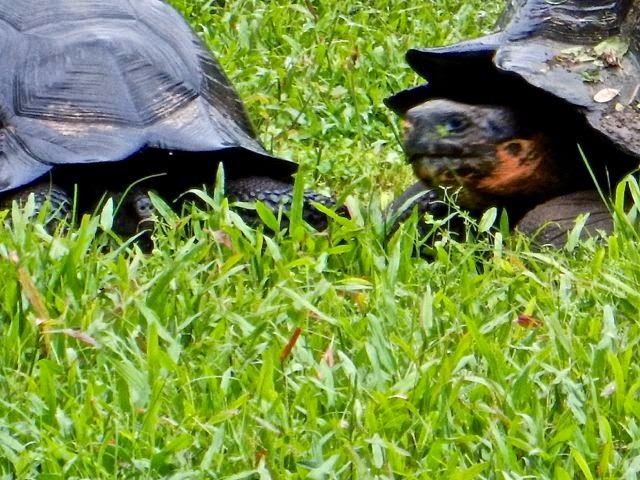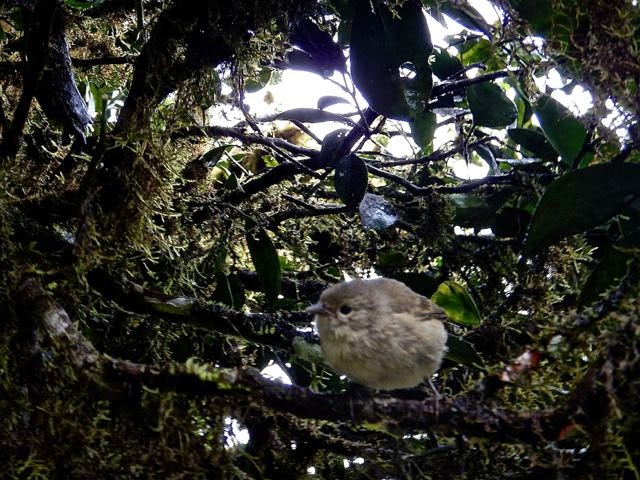 |
| Wet ones |
A 5:30 wakeup call, a good hot shower, a cappuccino, an hour traffic experience (lots of patrolmen in bright yellow vests making sure traffic doesn’t jam at cross streets and stoplights), and then a long wait in line to get the required permit to enter Galapagos Island, a magic carpet to an archipelago which has become a natural habitat for once castaway and now endemic animals. How these amazing turtles, iguanas, finches, boobies, golden sea lions and penguins got here, only God knows but man is trying to figure it out. There is a harmony in ordinariness and uniqueness and humanity is strictly the observer. For this reason the permits are limited and must be returned on departure so there is always an account of who is there as citizen or tourist and who departs when. Only five of the 125 islands have humans residing on them.
We landed on the hot, dry island of Baltra which was given to the US military during World War II to use as a base. Remnants of rusty concrete foundations still disturb the barren strip and we are driven quickly to a dock where we stumble aboard a small dinghy to take us across a small inlet to another dock on Santa Cruz island to meet our guide and driver.
 |
| Amazing moss |
 |
| Hairy moss |
There is a long straight tarmac road like an unfurled tongue that goes from one end of the island to the other, but oh the changes one experiences. We start in the dry lands or arid zone (all zones are affected by the south east trade winds called Garua on the windward side and how it affects the leeward side. ). Here the Palo Santos and the Pega Pega with pink or white bark (not white really, but covered in white lichens) and leaflessness make an erie pattern against the sky. Apparently when there is rain in this area, within 24 hours, green leaves will burst out and a flower blooms, only for a few hours. From the arid zone, rather flat, we begin to rise up through a transition zone – it’s getting greener and greener and misty with rain. Then we reach the scalesia forests that are deep emerald green, but, by fate of nature, those in the depths of Los Gemelos (the twin craters) are being strangled by masses of blackberry vines. This rare zone has constant precipitation but a threat to the indigenous plants has scientists mulling over ways to get rid of the blackberry vines without damaging the environment for everything else. Galapagos is always dealing with relations within nature and how to stop the naturalness of things being interrupted.
 |
| One of Dos Gemeles (twins) |
 |
| Litchens |
We got out our raincoats and trekked through the mud paths (don’t get off the path or touch anything) to have a look-see over the edge of the caverns but I was fascinated by the many flavors of moss on every tree – some stiff brown curly mosses that look like hair from a wig; others pale celery green moss like something in the bayou hanging in a breeze. From this level , about 1000 feet upward, moss is everywhere. Then there is a Brown zone where liverworts, epiphytes which cling to trees but do not depend on them; then the Miconia zone, where miconias, leafy bushes two to four meters high and with long leaves that resemble cacao leaves are endemic. (Mind you, we are still riding in the car up the long road through these zones as we increase in altitude.)
Then the Pampa Zone which is where fern and grasses take over at about 4000 feet max. Here windy and misty land with no trees, so mostly water plants, swamps, peat bogs and waterholes and four species of orchids. The only tree is the tree fern. It was really an environmentalist paradise passing through each of these zones so quickly so one could experience the change of climate.
 |
| Friendly chap (no zoom) |
 |
| Mud is Heaven
|
 |
| Is Love in Bloom? |
We cut out at the top zone near Santa Cruz to visit one of the private farms where the Giant Galapago tortoises roam the dirt roads and rich grassy and muddy fields. Strange that the ancestor to these “ Geochelone chiliensis, originally came from Argentina, but how is unknown. Males weigh up to around 500 pounds and move at the pace of….. a turtle. One foot at a time. Head sticking out to peruse his surroundings, usually with green leaves hanging from his mouth. They love mushrooms off fallen trees too, if they can reach them. They sleep in dried grasses that become like conal huts. If they are in the middle of the road, you wait until they move on off. We had to put on galoshes to walk through the wet mud and grasses and get about as close to them as you can get without riding them. They don’t zip into their shells, like most small turtles do when humans or dogs near. These just take it as it comes, knowing they are in a paradise where the land is their land, and we are the visitors. The mating season must have been on because we came upon a male and his small female discussing things face to face. She was obviously not
 |
| The Tent |
interested or she would have turn her tail toward him. Ahem.
The only historical predator to these reptiles has been man. First pirates, then the wealthy who wanted to hang their shells on their walls. Now, the new problem is the presence of black rats (introduced by pirates), feral pigs and feral dogs, the current plague. Any eggs laid on any island are brought to the Darwin Station and incubated for four years safety and then released into the various islands of the archipelago.
 |
| Warberler to sing us to sleep |
Our nights are spent at the Galapagos Safari Camp, which is literally tents on stilts with electricity. No walls. No windows, all netting and canvas flaps that are zipped up at night so the bugs don’t get in. We have a few across trees hung with moss where finches, yellow warblers, mockingbirds come up on the deck to see what we are doing. The music is amazing. No TV. No wi-fi. No newspapers. Good food. Nights are dark, stars are bright. Beds are soft. Sleep is welcomed.
Note: Fabulous foots by my daughter Mary Murphy. I lost my camera on
the airplane.










